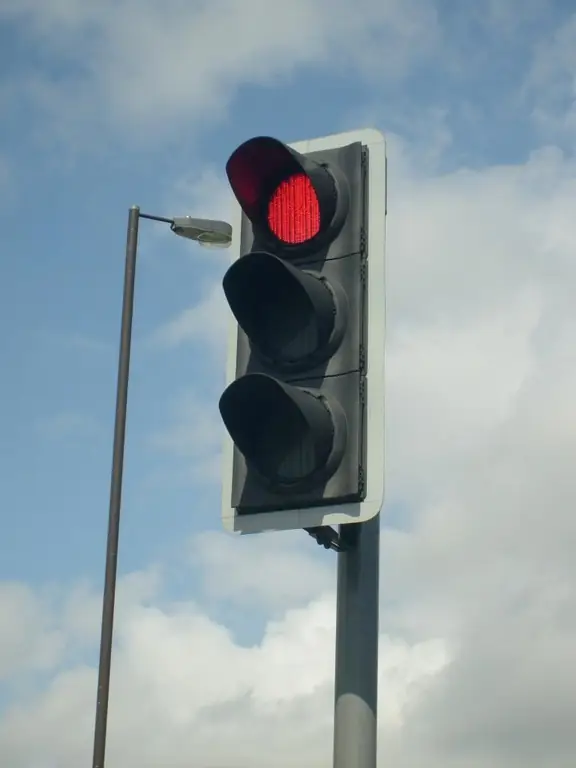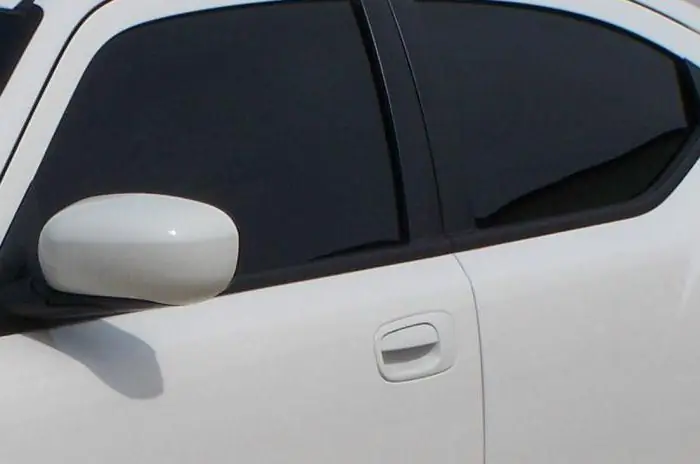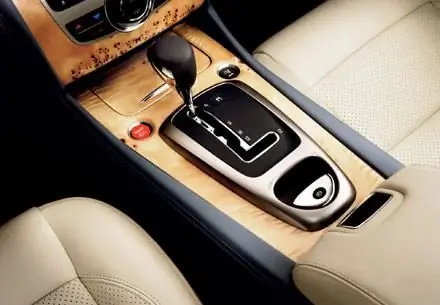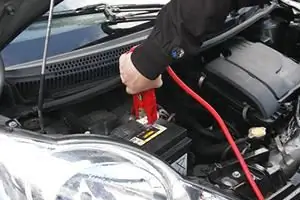2025 Author: Erin Ralphs | [email protected]. Last modified: 2025-01-22 21:14:12
Modern vehicles are hard to imagine without tinted windows. However, the light transmission of tinting must meet regulatory requirements. It is determined with the help of special devices by traffic police officers. If the work on applying the protective layer is carried out correctly, there will be no problems with the law.

Why tint a car?
Before talking about the light transmission of tinting, you need to decide whether it is needed in each case. To do this, it is enough to study the main advantages that car window tinting provides. There are quite a few of them:
- high decorative possibilities;
- prevention of internal interior elements from burning out;
- protecting the driver from dazzling ultraviolet rays;
- privacy of personal space;
- overheat prevention.
As an additional advantage, one more advantage can be noted, which is achieved when using durable films. This is an increase in safety in case of an accident. Some types of materials used allow you to delaybroken glass particles.

What factors might be holding back?
Despite these advantages, car tinting has a number of significant disadvantages. They are listed below:
- slight decrease in visibility;
- the possibility of applying pen alties for non-compliance with certain requirements;
- the likelihood of defects on the glass with improper darkening.
Many consumers are not afraid of these cons. Therefore, the application of protective layers from ultraviolet radiation continues to be popular. Disadvantages can be offset through the use of quality materials and a clear study of the basic requirements.
Basic light transmission standards
When the ban on tinting was lifted, motorists began to actively darken the windows. However, they often do not take into account light transmission indicators, which leads to the application of pen alties. When applying protective coatings from ultraviolet radiation, one should be guided by the points of GOST.
State standards allow vehicles to be driven with a tint light transmission of 70 percent for the windshield. Shading strips less than 140 mm wide are also permitted on the front. They are located strictly at the top. As for the front side windows, they must also transmit at least 70% of the light. This is necessary so that the driver can see clearly to the sides and front. There are no tinting requirements for other glasses if rear-view mirrors are installed on the sides.

The parameters presented should not be applied directly to the purchased film or sprayed layer. It is also necessary to take into account the light transmission of the glass itself, since this indicator is not one hundred percent.
Thus, although the ban on tinting has been lifted, there are certain restrictions regarding the dimming of windows that are on the side and front of the driver. Therefore, when applying coatings, there must be a balanced approach. Otherwise, you can get into an unpleasant situation with law enforcement officers.
Protective coating methods
Most often, car tinting is done using specialized films. The simplicity of this method allows motorists to carry out work without contacting workshops. If necessary, such a coating can be dismantled from the glass surface, which is relevant when claims are made by traffic police inspectors. There are many types of films that differ not only in aesthetic but also in practical characteristics.
Another option to darken glass is to apply a special coating at the factory. It is resistant to mechanical stress. To obtain a high-quality layer, expensive equipment is needed. At home, it is problematic to achieve an acceptable result.

In some cases, side windows are tinted by means of removable panels that are coated. If desired, they can be as quickly as possibledismantle. Dimming the interior with such elements is relatively cheap.
Innovative types include electronic vehicle tinting. An electrochemical composition is applied to the glass surface. Transparency with this option varies depending on the ambient light. There are simply no problems with driving a car at night.
Light transmission testers
A taumeter is an auxiliary device for determining the percentage of penetration of sunlight. With its help, traffic police inspectors measure the degree of light transmission. The devices shown in the table are widely used.
| Name | Conditions | Description |
| "Glare-N" | Measurements are made at temperatures from -10 to 40 degrees. The thickness of the glass should be 3-10 mm, and the relative humidity of the air should not exceed 95% | Enjoys the highest popularity among other analogues. Differs in the compact sizes. The mass of the device is 900 g |
| "Tonic" | Can be used on glass up to 2 cm thick. It is recommended to use it in the temperature range from -10 to 40 degrees | It is a portable device. Operates from a small power supply of 3.6 volts. The weight of the product is only 500g |
| "Light" | The width of the test specimens should vary between 3-6mm. Measurements can be taken at any time of the day at temperatures from -40 to 40 degrees | Not very convenient to use, as it weighs 1.4 kg. In this regard, traffic police officers are used relatively rarely. It is a stationary device of continuous action |
The listed devices allow you to successfully determine the permitted percentage of tinting on the front windows. The rear dimming level, as mentioned above, is not checked by inspectors. However, the error of these models can still fluctuate within 2-4 percent.

Features of measurements
Taumeter, like any other measuring device, must be certified without fail. These events are usually held annually. After verification is completed, a certificate is issued to the device if it meets all requirements.
The working mechanism is as follows.
- First, the test sample is illuminated by the emitter.
- Next, a certain proportion of the light flux goes directly to the receiver.
- Then, the captured radiation is transformed into a digital signal and displayed.
In order for the readings of technical equipment to be reliable, special requirements are imposed on its use. They are as follows:
- prerequisite is the presence of a seal ondevice;
- the date of the next inspection should be indicated on the label;
- measurements should be made three times in different places, calculating the average;
- The test sample must be cleaned of contamination before readings are taken.

Road check conditions
An inspector or an employee of the technical supervision of the traffic police can use the device to measure the tint. Checks should be carried out at stationary posts or checkpoints. Although when stopping outside the post, traffic police officers may offer to be tested with a special device, in fact there is a chance to refuse this.
The inspector can force you to go to a stationary point of service of the traffic police only if he draws up an act of detention. However, this requires very serious grounds that will be discovered without identifying a specific violation. And it is impossible to determine the light transmission of tinting by eye.
About film coating selection
Since the option with sticking the film is in great demand, it is worth dwelling on it in more detail. First of all, you need to choose the right coating for your car. Colored films are very popular. Glare does not appear on them, moreover, they are able to reflect up to 20 percent of thermal radiation. The main disadvantage is the relatively fast discoloration.
Metalized films are more UV resistant. The protective layer in this case is located between the mainlayers or on the inside. The level of reflection of thermal radiation can reach 70 percent. In sunny weather, such coatings acquire a metallic sheen.
When choosing colors, they are usually guided by aesthetic preferences. There are a large number of shades. However, the acquired coverage should not distort the perception of green and red colors.
Self application of tint film
Having learned what percentage of tinting according to GOST is acceptable in the Russian Federation, as well as having read the recommendations for choosing the base material, you can proceed directly to the work. The film will be applied to the glass using a set of specific tools and auxiliary equipment.
Preferably cooked:
- paper napkins:
- sprinkler;
- blade or stationery knife;
- rubber spatula;
- detergent.
First of all, the glass to be tinted is carefully washed. Even small grains of sand that have fallen under the coating cause serious defects. A foam solution is applied to a clean surface using a sprayer. A protective layer is removed from a workpiece cut from a large piece of film. The fitted part is superimposed on the glass.
Air bubbles are smoothed out with a rubber spatula. Drying is carried out after uniform distribution of the coating. For these purposes, a regular hair dryer is used. Glass with adhesive film is not recommended to be lowered or raised within 72 hours.

Optimal light transmission options for rear windows
The most popular tint is 35 percent. Such films are glued only to the surface of the rear windows. They allow you to effectively protect the interior from the negative effects of sunlight, while visibility deteriorates not so significantly. They are most often used for light-colored cars.
Another option is tinting 15 percent. In this case, the emphasis is on increasing the degree of dimming. Despite the rather low light transmission, visibility remains acceptable. This tint is perfect for dark colored vehicles.
Final part
The national standard for determining the level of light transmission of applied films and spray coatings must be observed in order to ensure road safety. This applies primarily to the front windows, through which the main view is opened for the driver of the vehicle. The darkening layer blocks visibility while riding. However, this level depends on the throughput of purchased materials.
Recommended:
SDA paragraph 6: what does the flashing green traffic light mean, how to navigate the traffic light correctly

From childhood, we are familiar with traffic lights, but in detail the features of their work are studied only by drivers. They know what a flashing green traffic light means and what pitfalls are hidden behind these artificial traffic controllers. In paragraph 6 of the SDA (except for paragraphs 6.10-6.12) talks about how to navigate by traffic lights, and what types of these devices exist
Types of car tinting. Car window tinting: types. Toning: types of films

Everyone knows that different types of tinting make the car more modern and stylish. In particular, dimming the windows in a car is the most popular and popular way of external tuning. The whole advantage of such modernization lies in its simplicity and relatively low cost of the procedure
The automatic transmission device of a car and the principle of operation. Automatic transmission types

Recently, automatic transmissions are gaining more and more popularity. And there are reasons for that. Such a box is easier to operate and does not require constant “play” with the clutch in traffic jams. In large cities, such a checkpoint is far from uncommon. But the automatic transmission device is significantly different from classical mechanics. Many motorists are afraid to take cars with such a box. However, the fears are not justified. With proper operation, an automatic transmission will last no less than mechanics
A device for measuring battery capacity. Basic ways

The article describes various devices that measure battery capacity. Also here is a method for making such a device with your own hands
How to “light up” a car from a car? How to “light up” an injection car?

Probably every driver has faced such a problem as a dead battery. This is especially true in winter cold. In this case, the problem is most often solved by "lighting up" from another car

